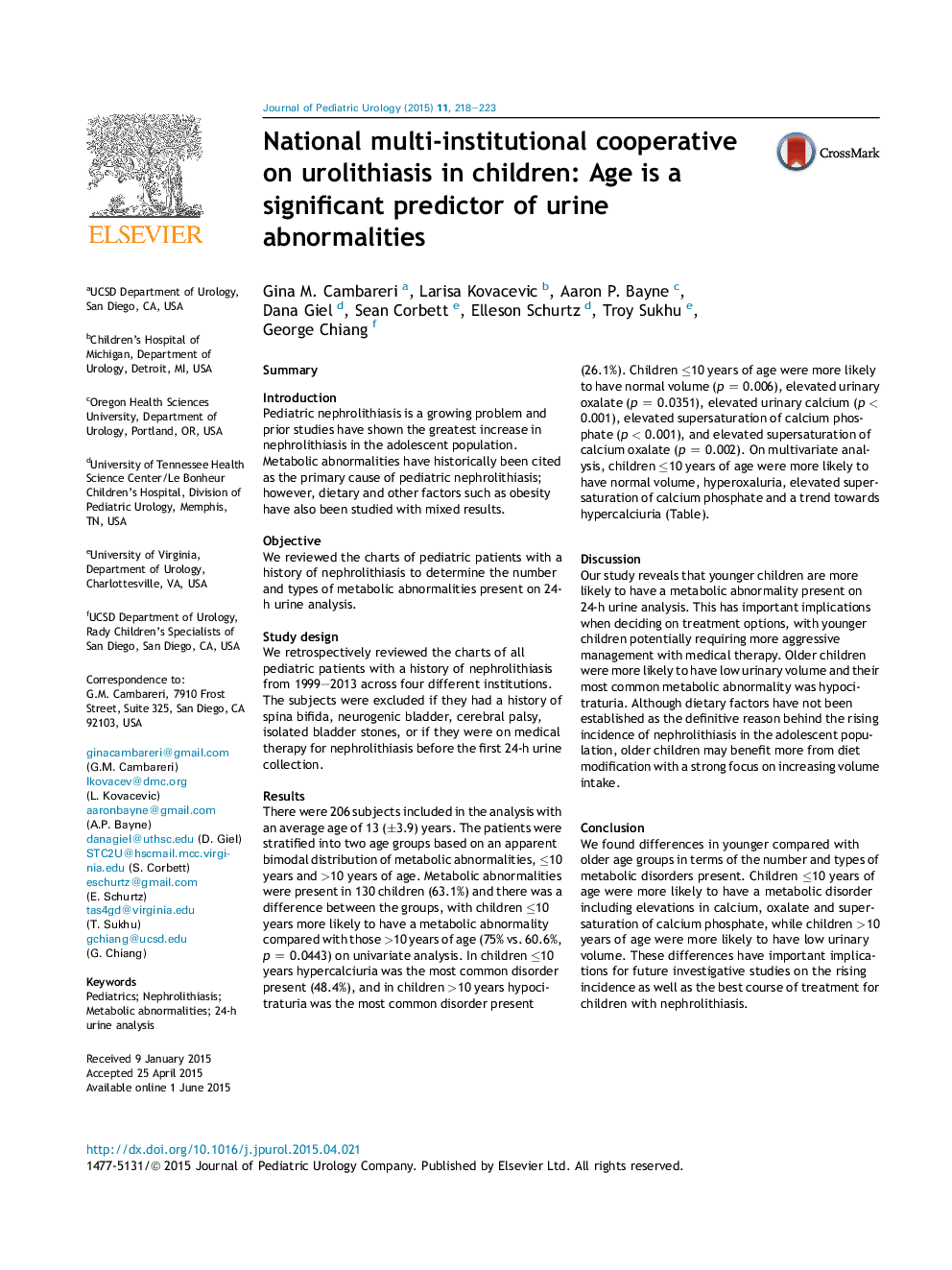| کد مقاله | کد نشریه | سال انتشار | مقاله انگلیسی | نسخه تمام متن |
|---|---|---|---|---|
| 4162196 | 1274273 | 2015 | 6 صفحه PDF | دانلود رایگان |
SummaryIntroductionPediatric nephrolithiasis is a growing problem and prior studies have shown the greatest increase in nephrolithiasis in the adolescent population. Metabolic abnormalities have historically been cited as the primary cause of pediatric nephrolithiasis; however, dietary and other factors such as obesity have also been studied with mixed results.ObjectiveWe reviewed the charts of pediatric patients with a history of nephrolithiasis to determine the number and types of metabolic abnormalities present on 24-h urine analysis.Study designWe retrospectively reviewed the charts of all pediatric patients with a history of nephrolithiasis from 1999–2013 across four different institutions. The subjects were excluded if they had a history of spina bifida, neurogenic bladder, cerebral palsy, isolated bladder stones, or if they were on medical therapy for nephrolithiasis before the first 24-h urine collection.ResultsThere were 206 subjects included in the analysis with an average age of 13 (±3.9) years. The patients were stratified into two age groups based on an apparent bimodal distribution of metabolic abnormalities, ≤10 years and >10 years of age. Metabolic abnormalities were present in 130 children (63.1%) and there was a difference between the groups, with children ≤10 years more likely to have a metabolic abnormality compared with those >10 years of age (75% vs. 60.6%, p = 0.0443) on univariate analysis. In children ≤10 years hypercalciuria was the most common disorder present (48.4%), and in children >10 years hypocitraturia was the most common disorder present (26.1%). Children ≤10 years of age were more likely to have normal volume (p = 0.006), elevated urinary oxalate (p = 0.0351), elevated urinary calcium (p < 0.001), elevated supersaturation of calcium phosphate (p < 0.001), and elevated supersaturation of calcium oxalate (p = 0.002). On multivariate analysis, children ≤10 years of age were more likely to have normal volume, hyperoxaluria, elevated supersaturation of calcium phosphate and a trend towards hypercalciuria (Table).DiscussionOur study reveals that younger children are more likely to have a metabolic abnormality present on 24-h urine analysis. This has important implications when deciding on treatment options, with younger children potentially requiring more aggressive management with medical therapy. Older children were more likely to have low urinary volume and their most common metabolic abnormality was hypocitraturia. Although dietary factors have not been established as the definitive reason behind the rising incidence of nephrolithiasis in the adolescent population, older children may benefit more from diet modification with a strong focus on increasing volume intake.ConclusionWe found differences in younger compared with older age groups in terms of the number and types of metabolic disorders present. Children ≤10 years of age were more likely to have a metabolic disorder including elevations in calcium, oxalate and supersaturation of calcium phosphate, while children >10 years of age were more likely to have low urinary volume. These differences have important implications for future investigative studies on the rising incidence as well as the best course of treatment for children with nephrolithiasis.Table. Multivariate analysis.Age (≤10 years vs. >10 years)ORConfidence limitspLow volume vs. normal volume0.460.2150.980.0443Oxalate (hyperoxaluria vs. normal)2.2291.0444.7580.0384Calcium (hypercalciuria vs. normal)2.0810.9714.4610.0595Super saturation calcium phosphate (elevated vs. normal)3.1291.4576.7190.0034Full-size tableTable optionsView in workspaceDownload as CSV
Journal: Journal of Pediatric Urology - Volume 11, Issue 4, August 2015, Pages 218–223
